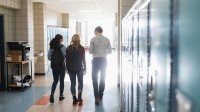Building Authentic Relationships With Students
Borrowing some ideas from psychology can help forge strong relationships with high school students, improve their academic performance, and promote a sense of belonging.
Your content has been saved!
Go to My Saved Content.It’s well documented that developing meaningful friendships is becoming more difficult and more rare, among both adults and teenagers. For American teenagers, loneliness and sadness are widespread. For female teens, it’s even worse.
This reality challenges teachers more than ever to develop healthy relationships with students. Not only does this impact individual academic performance, but also it could improve the social and emotional health of students by helping to give them a sense of belonging. Psychology offers insight into building relationships that teachers can utilize in the high school classroom for positive rapport with students.
Proximity
Building authentic relationships takes time. Researchers cite spending approximately 40 to 50 hours together as the threshold for establishing a friendship. Adults often do this by sharing a common activity, such as video games or a recreational sport. Of course, no one is suggesting that teachers and students should become friends, because appropriate boundaries should always be set and maintained. For example, social media relationships for solely personal reasons, especially DMs, aren’t appropriate between teachers and students because they break down any semblance of professionalism.
In the classroom, relationships with students can’t be rushed. Teachers can be confident that consistent kindness, saying students’ names, and general interactions with students will build relationships with students after 40 to 50 hours of proximity. Every student is different, so some will warm up to teachers immediately, while with others it might take much longer. In high school, 40 to 50 hours could take place over three to four weeks, so patience is important.
‘I need help’
Psychologists say that asking for assistance is a great way to become friends with someone. For example, with adults, asking a new acquaintance to help you with something like building a shed or pressure-washing your house forges a lasting bond with that person. This shows a level of vulnerability on behalf of someone asking for help while simultaneously displaying trust in the person willing to give the help.
Within the classroom, teachers can ask students for help in a variety of ways, both important and trivial, that foster trust. Teachers can tell students, “I need help,” by asking them to take something to the main office or creating a Kahoot game to use for review. These acts help build rapport with students because they make students feel special, trustworthy, and an integral part of the classroom community. This provides students with a sense of ownership in the classroom and the knowledge that their voice matters.
Callbacks
Callbacks can be conversations recalling a story, person, experience, or place that enriches a relationship. According to psychologists, shared experiences deepen relationships between individuals. For example, if two people went to the same college and had the same professor, a callback would be discussing the quirks of the professor. These shared experiences are often accompanied by humor, nostalgia, and a sense of community.
When callbacks are applied to the classroom, teachers recall with students a shared experience. This becomes easier as the semester or school year progresses, and it can make relationships with students more authentic.
A callback example could be a teacher setting off the fire alarm due to overcooking their Hot Pocket. Those 10 to 15 minutes spent outside waiting for the fire department can lead to positive interactions and relationships with students for the remainder of the semester.
In addition, making a callback to a guest speaker, extracurricular activity, field trip, school dance, fond memories from a previous teacher, or another school experience strengthens the bond between teacher and student. Recalling a past experience humanizes everyone involved and helps students associate positivity with the school experience.
Authenticity
Building relationships with students involves authenticity. In my first year of teaching, I was so desperate to establish myself as an authority figure that I put up a charade as someone who didn’t tell jokes and didn’t have a personality outside the classroom. I was miserable, and so were the students.
Teachers should embrace who they are, and students will appreciate it. Don’t hesitate, during downtime or with room decor, to share your hobbies, your interests, books you’re reading, and music you like. When students found out that I listened to Blink-182, Sum 41, Simple Plan, Michelle Branch, and Avril Lavigne, they responded positively (and audibly laughed). In addition to sharing, during classroom downtime, ask students about their lives, what they like, and how they are.
This authenticity builds positive relationships that not only help academic performance but also fight loneliness and sadness. This isn’t a substitute for therapy, of course, but it does trend in the right direction.
Keep in mind that even after all these attempts, there will be some students who won’t like you as a teacher. That’s OK. You can still have mutual respect and kindness with each other that can lead to meaningful learning. Borrowing principles from psychology, teachers can employ proximity, “I need help,” callbacks, and authenticity to help cultivate positive relationships with students.
